In this article we look at the best fire extinguishers for the home, along with the correct type of extinguisher for recreational pursuits such as caravans, camping, on the road in a motor home or even on a boat.
Different fires require different methods of extinguishing. Using the wrong fire extinguisher can not only be useless but it can instantly make the fire worse causing serious harm, further property destruction or even death.
Reviewed for 2023
Reviewed by Paul (Admin) (Dip NCRQ, IOSH, NEBOSH Fire Safety and Risk Management)
Affiliate Disclosure. By clicking on any links in the article, AT NO EXTRA COST TO YOU, I may earn a small commission from any purchase you make. This is one way I run and maintain this site. Thank you and I hope you get value from the information.
IN THIS ARTICLE:
What Are The Different Classes of Fires.
Best Fire Extinguisher For The Home.
Best Fire Extinguisher For Kitchen.
Best Fire Extinguisher For a Barbecue
Best Fire Extinguisher For a Car.
Best Fire Extinguisher For Camping.
Best Fire Extinguisher For a Motorhome or Caravan
Best Fire Extinguisher For Camping.
Best Fire Extinguisher For a Boat
What are the different classes of fire?
While fire can combust and burn from a whole array of flammable materials, all fires have 3-essential elements required to ignite and burn.
These are:
1. A Source of Ignition.
2. A Combustible/Flammable Material or Liquid.
3. A Readily Available Source of Oxygen.
This is known as the FIRE TRIANGLE, and without just one of these 3-elements a fire cannot either ignite or continue burning.

Fire classifications.
In the UK (and most other countries) fires are laid out into different classifications according to their fuel source. By understanding how these fuel sources can be extinguished safely allows us to determine which type of fire extinguisher to purchase and use in case of emergency.
It’s important to remember that by using the wrong fire extinguisher you can make the situation far worse, and even deadly.
An example of this would be using a fire extinguisher containing water on an electrical or cooking oil fire. We all know that water and electricity don’t mix and if sprayed on a live electrical appliance it can become deadly.
Similarly, water sprayed on to a burning pan fire can react very badly causing burning globules of fat or oil to splatter around the area setting fire to surrounding surfaces and materials. It can even explode back towards the person fighting the fire causing serious burns and other injuries.
5 Classifications of fire.
In the UK, there are 5 primary classifications of fire, and your extinguisher needs to be suitable for the area you intend to protect.
- Class A. Fires involving mainly organic solids (paper, wood, plastic etc)
- Class B. Fires involving a flammable liquid. (petrol, oil, paints) This also includes liquefiable solids (waxes, grease, fats – but not cooking oil or cooking fat).
- Class C. Fires involving gases (liquid petroleum gas-LPG, butane and propane)
- Class D. Fires involving certain metals (magnesium, sodium, aluminium).
- Class F. Fires involving deep fat/oil fryers.
You will notice that Class E has been skipped over. This is because this classification was for electrical fires. The advice from the fire industry now is to avoid potential electrocution by disconnecting the burning electrical appliance from the power source by either unplugging at the socket if possible, or switching off the whole electricity supply at the fuse box.
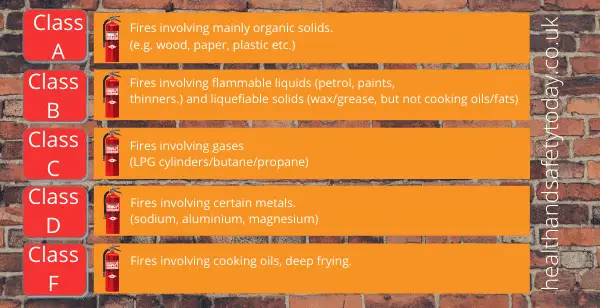
At that point the appliance can be treated as a normal fire (usually plastic and some lightweight metal, which would be a CLASS A fire).
Best fire extinguishers for the home.
Leaving the kitchen and garage aside for the moment, the majority of potential flammable contents around the home can be found in the living and sleeping areas. (lounge, dining area, bedrooms, home office, entrance hall, bathroom (incredibly).
Typically, the items that could ignite easily are newspapers and magazines, soft furnishings, wall coverings and decorative wall art, furniture, curtains and blinds, artificial plants and flowers etc.
Sources of ignition
Common sources of ignition will often be candles, open fires, discarded smokers material, overheating or short-circuiting electrical appliances.
Other sources of ignition are portable electric fires where dust has accumulated inside or something has been draped over/fallen against the fire, hairdryers/curling wands in the bedroom left on the bed or rug still switched on and electric blankets etc.
More frequent are incidences of mobile phone chargers bursting into flames, especially the cheap imitation brands from untrustworthy sources, as well as plug in aromatherapy units which are often left running all day unattended.
All these hazards have the potential to start a house fire very quickly by spreading to readily available combustible materials.
What fire extinguisher for what fire?
In the vast majority of cases, the incidence of fire within the living areas of a typical home is fuelled by organic material. Organic material can be classed as paper, wood, plastic, natural and man made fibres etc.
This is called a CLASS A fire and can be extinguished by either cooling or smothering.
Cooling takes the heat out of the burning material, which makes it difficult for the fire to reignite afterwards, while smothering the fire starves it of oxygen. However, smothering does not immediately cool the fire and if oxygen is reintroduced too soon, the fire may start up again.
Fire extinguisher for Class A fire.
Most small CLASS A fires can be successfully extinguished by using an extinguisher containing water.
Water filled fire extinguishers are identified by a RED band around the cylinder.
Water filled fire extinguisher. PROS.
- Generally the cheapest to buy and most readily available of all fire extinguishers.
- The contents are environmentally friendly when discharged.
- The contents are not harmful in any way to the user or others in the dwelling.
- Water instantly cools the burning material and prevents re-ignition.
- No lasting damage to the property.
Water filled fire extinguisher. CONS.
- Must never be used on a burning live electrical appliance. Always disconnect the appliance from the socket if possible, or switch off at the fuse box before discharging the water contents.
- Never use on a pan fire or burning cooking oil (see kitchen alternative below)
- Discharges in a narrow jet, so limited coverage.
- Contents can drench the surrounding area potentially seeping through the floorboards into the room below, or seeping into the plaster-work. (However, water dries quickly and is usually resolved with a bit of DIY afterwards).
Alternatives to water.
Other fire extinguisher contents contain foam or dry powder.
Foam filled fire extinguishers are identified by a CREAM band around the cylinder.
Dry Powder filled fire extinguishers are identified by a BLUE band around the cylinder.
Each has their own purpose, but both can be used as an alternative to water on a CLASS A fire (although dry powder generally isn’t recommended in small enclosed indoor areas).
Foam fire extinguisher. PROS.
- Works by forming a layer on top of the fire to smother and starve the oxygen.
- Much better spread than water so may tackle a fire more efficiently.
- Foam layers over the fire rather than a solid jet of water at the fire which may cause the burning material to move position.
Foam fire extinguisher. CONS.
- Poor cooling effect compared to water which means that re-ignition may occur if the burning embers are disturbed too soon.
- Very messy and possibly destructive to surrounding furnishings.
- Not generally environmentally friendly.
- Not suitable on electrical fires or cooking fires due to moisture content.
Dry powder fire extinguisher. PROS.
- Can be used on live electrical fires (no moisture content).
- Has the ability to extinguish the fire faster than foam.
- Works by both smothering the fire and chemically inhibiting re-ignition.
Dry powder fire extinguisher. CONS.
- Offers little cooling so a fire may re-ignite.
- Leaves a lot of residual mess.
- Can obscure vision, especially in a small or confined area.
- Possibility to aggravate medical conditions such as asthma and other respiratory conditions.
- Should never be used near or on animal feed or bedding.
Best fire extinguisher for kitchen.
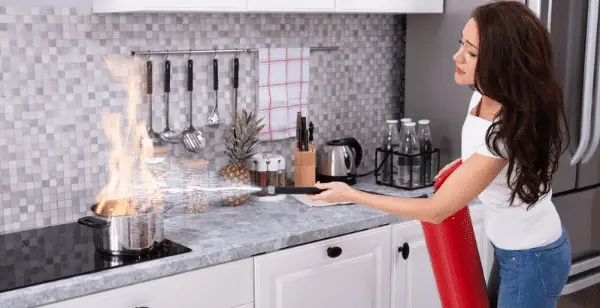
Unlike choosing a fire extinguisher for the living areas of a home, the kitchen is a more dangerous and complex environment.
In the kitchen there can often be a mix of organic combustible items, electrical or gas cooking appliances, and the potential of fires from cooking oils, grease and fat.
On the face of it a powder extinguisher rated for ABC fires would be a good all-rounder for tackling everything other than a pan or cooking oil fire.
Kitchen fire safety
However, in a relatively small space such as the kitchen it’s worth remembering that the powder can be a very dry irritant to those with breathing difficulties and chest problems. And, even though powder can be used on an electrical appliance because it’s a dry substance, it is still advisable and safest practice to disconnect any burning appliance from the power source first.
Traditionally, the best way to tackle any kitchen fire, whether it was caused by oil, grease, electrical (i.e. a toaster), or organic material was to smother it with a fire blanket and starve the oxygen.
Fire blanket use
Using a fire blanket is still sound advice, and branded CE marked fire blankets that comply to British Standards cost very little money and are reasonably unobtrusive when mounted in an accessible place.
The downside to a fire blanket is that you need to be able to get close enough to the fire to safely drape it over without knocking over or dislodging the pan and spreading the fire further. Pan fires have the potential to be very dangerous if you panic. SO KEEP CALM.
Remember that you must also switch off the power source to the burning pan whether it be gas or electric, otherwise it will cool and never extinguish.
ALTERNATIVES TO A FIRE BLANKET ON A PAN FIRE.
It’s been a long time coming but there is now a safer alternative to tackling a pan fire in the home other than using a fire blanket.
Cooking oil fires are regarded as a CLASS F fire and require a special chemical that spreads across the surface of the burning oil smothering the oxygen and providing a cooling effect. This all happens without any splattering of the oil which happens if water or moisture is introduced.
Class F fire
Traditionally, a Class F fire extinguisher was very expensive to purchase, required regularly checking and were specified for use in commercial kitchens only. They were considered prohibitive for home use.
There is now a product on the market that has award-winning properties for tackling pan fires, and has been developed to be very affordable for home emergency use. It has similar properties to the CLASS F fire extinguisher but comes in a handy sachet which you gently place into the pan fire.
You can see it in action in the video below.
<<< FIND OUT MORE ABOUT FIREXO PAN FIRE EXTINGUISHING SACHETS HERE >>>
Garage fire extinguisher.
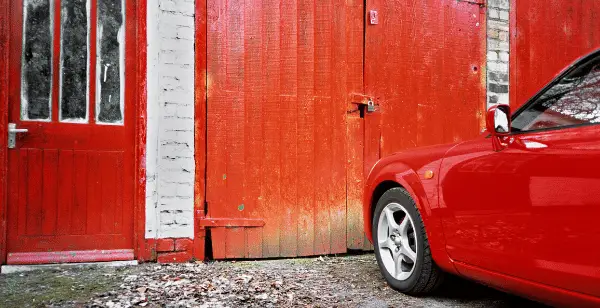
Home garages are often a dumping ground for anything we have an excess of or don’t know what to do with. Subsequently they house a whole mix of flammable products, and the scary part is that a fire could start and take hold unnoticed.
For this reason it is highly advisable to install a smoke alarm in a garage, although I suspect not many people do.
Garage fires
When you think about the contents of a typical domestic garage, what might it contain?
- Garden tools including a lawnmower, which might be petrol powered.
- Fuel canister with potentially a gallon of petrol.
- Left over decorating materials, wallpaper, paint and white spirit.
- Possibly boxed up clothes and books we’ve been meaning to take to the charity shop.
- Barbecue supplies, coals, lighting fluid, or maybe even a gas canister if we have an outdoor BBQ.
- Perhaps our central heating boiler is located in the garage, along with the fuse box for the whole house. (I know both mine are).
- We will certainly have a power supply or two with things plugged in such as battery chargers for power tools, or even a spare fridge/freezer. When you think about it, these things are often left plugged in for months on end without ever being checked on.
ABC fire extinguisher
To be honest, if a fire breaks out in your garage, by the time you become aware of it then it’s going to be pretty much out of control. The best option at that point is to get everybody out of the house to safety and call the emergency services, especially if it’s a garage that’s attached or integral to your house.
However, if a fire breaks out while you are present, and swift action will bring it under control then a powder fire extinguisher capable of tackling ABC fires would be well worth having attached to your garage wall.
<<< SEE MORE ON RECOMMENDED ABC RATED FIRE EXTINGUISHERS HERE >>>
BBQ fire extinguisher.

Hopefully your summer barbecue will go without a problem, and at the end of the evening the coals and embers will naturally cool to a point where they can be cleared up the next day and disposed of quite safely.
However, whether it’s a wood or charcoal barbecue or one fed by an LPG or butane canister, things can go wrong.
The flames may get out of control and set fire to something nearby such as a fence or gazebo. Or perhaps there is a leak on the supply hose from the gas canister causing a sudden gas related fire.
Despite the pleasure we get from outdoor cooking, it’s still something we do infrequently and has the potential to get out of control if we don’t pay attention.
Fire blanket use.
Most outdoor cooking fires will be of an organic nature (i.e. wood or material from an overhead canopy), or fueled by a flammable liquid or gas. Again, they can be extinguished with a powder filled fire extinguisher rated for ABC fires.
If you have one of these hanging on your garage wall, then as a precaution bring it outside whenever you get the barbecue out.
An alternative to this would be a fire rated blanket which you could drape over the barbecue to starve the fire of oxygen and bring it under control that way.
It’s also worth pointing out that should somebody tragically catch fire from barbecue, wrapping them straight away in a fire blanket will rapidly stop the flames and prevent further burns, possibly saving a person’s life.
<<< VIEW APPROVED ABC FIRE EXTINGUISHER AND BLANKETS HERE >>>
Fire extinguisher for a car
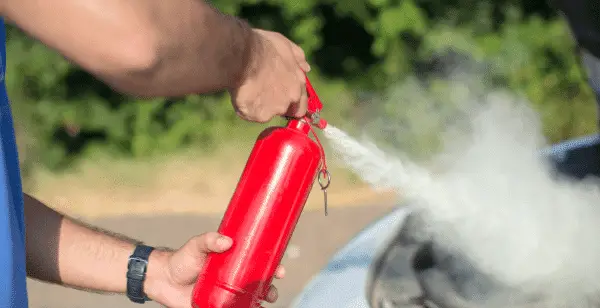
Every year in the UK, over 100,000 cars (which equates to nearly 300 a day) go up in flames and around 100 people die as a result.
“Source UK Fire Service”
Car fires are typically caused by electrical faults that ignite in the engine compartment or underneath the dash board, leaking fuel that ignites on contact with a hot engine, or carelessness with smoking materials causing the upholstery to ignite.
Other than the volatile nature of fuel and a fire in the engine compartment, the inside of the vehicle is made up of a cocktail of plastics, polymers and foams which are highly flammable and can be very toxic.
ABC fire extinguisher
The most appropriate extinguisher to keep in a car would be a small Dry Powder ABC extinguisher.
Never use water on an engine fire, it will react badly with the burning fuel and grease, plus short out the electrics causing further potential flare-ups.
If a fire does break out in your vehicle;
- Switch off engine. Release bonnet – Do Not Open
- Get everyone out of the vehicle.
- Get far away from the vehicle.
- Dial 999 and call the fire and rescue service.
- Keep away from the vehicle. If safe to do so, warn oncoming traffic.
If the fire is in the engine compartment and it is safe to quickly tackle then point the dry powder extinguisher through the radiator grille or under the edge of the bonnet and release the contents. DO NOT lift the bonnet. You risk the fire flaring up into your face.
VIEW MORE ON VEHICLE FIRE EXTINGUISHERS AND SAFETY
Fire extinguisher for camping
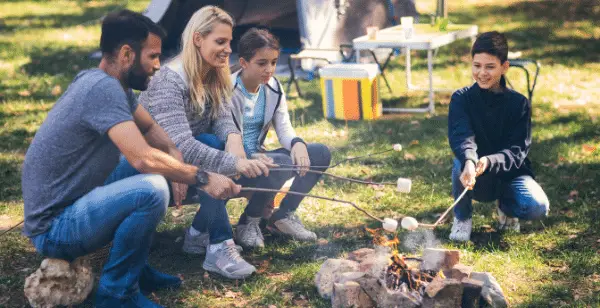
Although camping sounds like a really safe enjoyable pastime, it’s not without its dangers. The risk of fire is ever present from activities that we would not normally do at home.
For example, when camping we are back to nature – that’s the whole point of it. But it also means that we don’t have the everyday utilities that we take for granted at home such as light, power and heat. Therefore, as these three things are fundamental to life, we need to provide them cave man style with fire.
Things to consider for a safe camping experience.
Avoid using candles in the tent. Take a torch with spare batteries, or a wind up rechargeable torch with a good 60 minutes of light on one charge.
Avoid using storm lanterns in the tent (either lit with candles or any type of fuel.) Again, use a battery powered or rechargeable storm lantern for night time light.
Remember, tents are made of fabric and most of the items inside are fabric or some other combustible material. Once a tent catches fire it will go up really quickly so you need to get everybody out first before anything else.
Avoid cooking inside the tent. Apart from the obvious fire hazard there are additional dangers caused by carbon monoxide poisoning.
Contrary to popular belief, Co2 poisoning doesn’t just happen due to a faulty boiler or gas fire in the home. Co2 is created when fossil fuels combust poorly and don’t burn at the optimum temperature. Outdoors this isn’t a problem, but indoors the gasses get trapped and displace the available oxygen causing drowsiness and potential death.
Pitch up a tent
When you come to pitch up a tent, ensure there is sufficient distance between you and other tents (at least 6 to 7 metres), enough to create a fire break should your neighbouring tent go up in flames during the night.
Camp safety
Outdoor camp fires are great fun and can be managed safely.
Again, create a fire break around the camp fire by removing grasses and debris from the surrounding area. If possible create a ring of sand around the fire to stop the flames going any further out.
Use good quality branded firelighters to get the fire started, and DO NOT under any circumstances spray lighter fluid onto a fire to give it a boost.
Ensure your camp fire is set up with sufficient distance from your tent, other people’s tents and overhanging trees. Remember, you are likely burning twigs and branches which create floating burning embers and can easily land on somebody else’s pitch.
Always keep a bucket of water or sand close by in case things get out of hand, and remember to make sure the fire is fully cooled and dowsed at the end of the evening.
Outdoor cooking safety
When cooking outdoors observe the same tips as setting up a camp fire if you are going down the traditional route. If using a gas fired camping stove then it’s really important to check all your gas connections and hoses when setting up and before lighting.
A bucket of water on standby will rapidly cool any fire and a bucket of sand will starve a fire of oxygen.
However, these are bulky heavy items so it might be worth considering a small ABC type extinguisher to include in your camping kit which will rapidly dowse all types of organic fires, or a good quality fire blanket which will smother the fire and again starve it of oxygen.
Just remember to place it where it can be accessed quickly. If a fire breaks out in your tent, then the extinguisher is no good if it’s in the boot of your car parked half a mile away.
VIEW TRAVEL FIRE EXTINGUISHERS HERE.
 Best Prices On Amazon
Best Prices On Amazon
RV fire extinguisher

According to the Caravan and Motorhome Club of Great Britain, there are a number of common causes of fires in motor homes and caravans including (but not limited to).
- Pressurised containers (hairspray or shaving foam) kept in a cupboard adjacent to heat source (oven, space heater).
- Discarded matches and smokers materials.
- LPG/paraffin heaters.
- Incorrectly fused 12V or 240V wiring.
- Electrical wire runs squashed by items hurriedly loaded into caravan lockers.
- Clothes left drying near or on heaters and bedding touching heaters.
- Curtains or blinds falling too close to heaters or cooking appliances.
- Crocodile clips used on battery terminals instead of clamps, and any other unsecured wiring that can create sparks or heat.
- Under-bed lockers stuffed full of sleeping bags and pillows etc. This is often where the battery, mains isolating box, RCD, and airflow vents are located. A good source of free flowing air is critical to keeping electrics cool in a small environment such as a caravan or motor home
- Overloaded electrical sockets, adaptors and extension leads.
Fire extinguisher for cooking oil
In addition to all this there is the threat of fires from cooking, both indoors and outdoors. And in the case of motor homes, the rare but possible chance of an engine compartment fire (as discussed in best fire extinguisher for a car)
It’s recommended that all caravans and motor homes carry a fire extinguisher as standard kit, as well as properly fitted smoke alarms that should be tested each time you use your vehicle.
However, when it comes to a pan fire involving cooking oil, the use of an incorrect extinguisher can make the fire spread rapidly and even cause substantial injury.
For this situation it is best to also have a fire blanket located in an easily reachable and visible place, or use one of the products developed by FIREXO to tackle all types of fire safely.
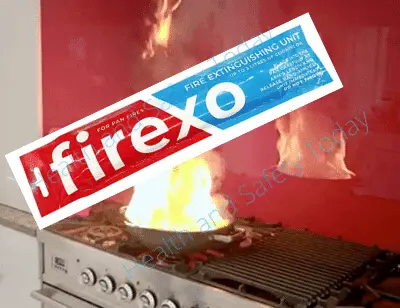
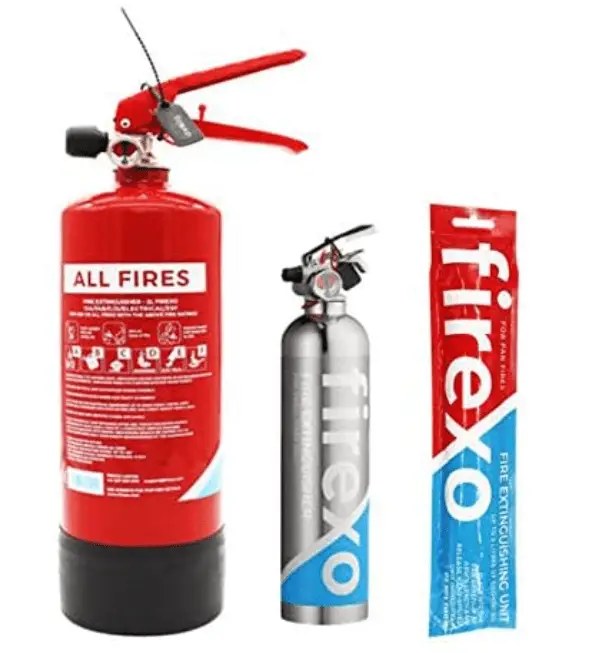
You can view videos on how the FIREXO pan fire satchet works at the end of this article, or read the FIREXO product review here.
The first rule of fire safety though in all cases is to get people out to a safe place first. Caravans and motor homes are small spaces packed with a lot of furnishings and equipment, and a fire will take hold very quickly. Therefore, preserving life must be your top priority. After that you can think about saving your vehicle and possessions.
Fire extinguisher for a boat

Boats offer unique challenges when it comes to fire, and despite being surrounded by water a fire can become disastrous very quickly.
There are many different types of flammable liquids carried on boats including spare diesel for the engine, possibly spare petrol for an outboard dinghy, cooking oil and chemicals for cleaning etc.
All situated in often a very confined space.
Therefore, most boat owners would need to carry out a risk assessment to establish what could potentially cause and accelerate a fire. This would give guidance to purchasing and maintaining the appropriate extinguisher.
Other health and safety rules also come into play, particularly if the boat is being rented out, or you host parties where employees or contractors maybe on board.
In these instances, the Health and Safety at Work Act (UK) would come into play and there would be a duty by the boat owner/employer to ensure the safety of those in the work place.
Additionally, larger craft have different regulations to smaller craft, and of course ships are different again.
Marine law and codes of practice
Laws managing safety for large ships are in the Merchant Shipping (Fire Protection: Large Ships) Regulations 1998 and laws regarding safety on small ships are in the Merchant Shipping (Fire Protection: Small Ships) Regulations 1998.
Since 1998, there have been a number of key amendments to the regulations, which are included in the Merchant Shipping (Fire Protection) Regulations 2003. It is essential to be aware of any changes in legislation and boat fire extinguisher rules.
The Royal Yachting Association has lots of information on their website around boating safety and fire and a very helpful resource for choosing and locating fire extinguishers which can be read here.
Which fire extinguisher to use?
So given all these different fire types that can occur in different situations around the home, cars, caravans, garages, recreation etc, what type of fire extinguisher should you purchase in case of emergency?
As we’ve discussed throughout this article, a dry powder fire extinguisher can be used on ABC fires and also electrical fires because it has no water content. For a lot of applications it’s a good choice.
However, the complication of dry powder is that it’s not recommended for use in a small confined space as its powder contents quickly get into the air, throat and lungs causing breathing and respiratory problems. Also, it’s ineffective on pan fires involving cooking oils and fats, and it leaves a lot of residual mess.
It is though very effective on external fires such as engine compartment fires, gas barbecues and flammable liquids.
Also, water filled extinguishers are not really suitable other than for quickly cooling an organic fire such as furnishings. If your fire is of an electrical nature or cooking oil then the use of water presents other hazards.
A carbon dioxide Co2 extinguisher is effective in putting out fires quickly and is safe on electrical fires, but it uses the principal of eliminating the oxygen supply to the fire. Again, in a small space such as a caravan, this could cause breathing issues.
Also, a Co2 extinguisher has no cooling effect so a fire can potentially reignite once the oxygen returns and there is a ready source of combustible material.
Advances in fire extinguishers.
Thankfully fire extinguishers are evolving and responding to the confusing nature of which type of extinguisher to use on which type of fire.
An international company called FIREXO has developed a range of fire extinguishing products that can tackle ALL FIRES safely and effectively, including pan fires and electrical fires.
YOU CAN FIND OUT MORE ABOUT THE FIREXO RANGE HERE
Watch the 2 quick videos below to find out how FIREXO sachets deals with a pan fire in the home, and the difference between trying to extinguish a pan fire with water and a pan fire using FIREXO.
FURTHER READING.
What are the different types of fire extinguishers?

1 thought on “Best Fire Extinguishers For The Home”